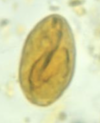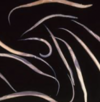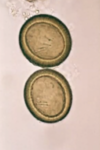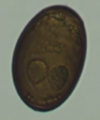STEEPLECHASE - Parasites Flashcards
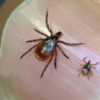
Nymph
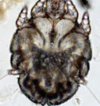
Sarcoptes - burrowing mite

Psoroptes - non-burrowing mite (e.g. Psoroptes ovis)

Sarcoptes scabiei - burrowing mite

Sarcoptic mange - burrowing mite
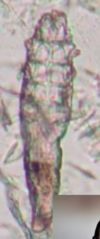
Demodex - burrowing mite

Demodecosis/demodectic mange

Psoroptes spp. (e.g. ovis)/sheep scab - non-burrowing mite


Chorioptes spp. (e.g. bovis) - non-burrowing mite

Otodectes cynotis - non-burrowing mite


Cheyletiella spp. - non-burrowing mite

Dermanyssus spp. - non-burrowing mite

Soft tick e.g. Argas spp. of birds

Hard tick e.g. Ixodes ricinus (castor bean tick in sheep) or Ioxdes hexagonous (hedgehogs)
Transmit babesiosis, Borrelia (Lyme disease), tick pyaemia, ehrlichiosis

Questioning hard tick (Ixodidae), waiting for host e.g. Ixodes ricinus (castor bean tick in sheep) or Ioxdes hexagonous (hedgehogs)
Transmit babesiosis, Borrelia (Lyme disease), tick pyaemia, ehrlichiosis

Engorged tick

Larva tick

Nymph tick

Haemonchus contortus (nematode), female “barber’s pole” appearance
Sheep - haemonchosis, absomasum, obtain blood from mucosal vessels before final moult

Strongyle egg, 80 micrometres (Nematodirus battus egg ~ 160 micrometres long)
E.g. Trichostrongylus axei (Sheep abomasum), Trichostrongylus spp. (Sheep small intestine), egg and L3 survive in environment under adverse conditions

Rumen fluke (trematode) eggs e.g. Calicophoron daubneyi
Immature in duodenum, adults in forestomachs
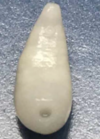
Adult rumen fluke e.g. Calicophoron daubneyi

Galba truncatula - intermediate host of rumen fluke e.g. Calicophoron daubneyi, and liver fluke e.g. Fasciola hepatica
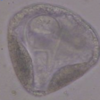
Moniezia benedeni/Moniezia expansa egg
Cestode parasite, adults in SI, calves & lambs, intermediate host = oribatid mite, solid mass of tapeworm could occlude intestinal lumen

Oribatid mite - intermediate host of cestode Moniezia benedeni/Moniezia expansa
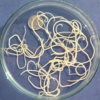
Toxocara canis adult worms (nematode)
Dogs

Toxocara canis roundworm

Anterior end of toxocara canis
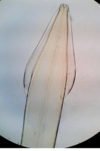
Anterior end of Toxocara cati

Unembryonated Toxocara canis egg ~80-85 by 75 micrometres

Unembryonated Toxocara cati egg 65-75 micrometres

Embryonated Toxocara canis egg

Ancylostoma caninum (hookworm)
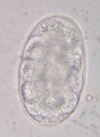
Ancylostoma caninum (hookworm) egg

Female hookworm in humans e.g. Necator americanus/Ancylostoma duodanale

Male hookworm in humans e.g. Necator americanus/Ancyclostoma duodanale

Cutaneous larval migrans - caused by zoonotic hookworm, Ancyclostoma braziliense

Dipylidium caninum (tapeworm)
Adults = non-pathogenic, SI of dogs and cats
Intermediate hosts = fleas/lice

Dipylidium caninum tapeworm in dogs and cats
Shed segments + may cause anal discomfort and itching, proglottids become more mature as go down worm, fleas/lice required for transmission


































